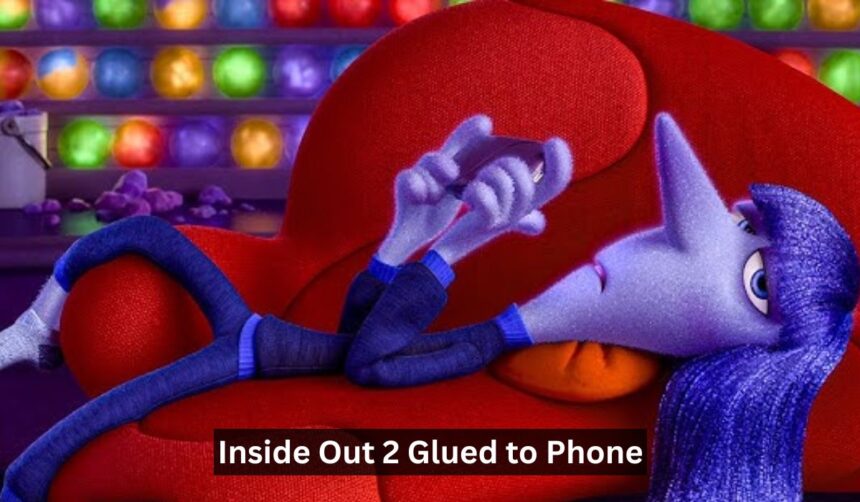Disney and Pixar’s Inside Out franchise has always stood out for its ability to turn complex human emotions into entertaining, relatable stories. With the release of Inside Out 2, fans are once again taken into Riley’s mind as she grows from a child into a teenager. While the sequel brings fresh emotions like Anxiety, Embarrassment, and Envy, one particular moment caught the audience’s attention: Riley being “glued to her phone.”
The Inside Out 2 Glued to Phone scene isn’t just a quick gag or throwaway joke—it’s a powerful reflection of the modern teenage experience. In today’s digital age, smartphones aren’t just devices; they’ve become extensions of identity, social interaction, and even mental health struggles. This article breaks down the scene, explains its deeper meaning, and explores why it resonates so strongly with both kids and adults.
Growing Up in the Digital Era
The first Inside Out movie showed Riley as a young girl navigating the challenges of moving to a new city. In Inside Out 2, she’s now a teenager entering a stage of life where identity, independence, and peer relationships dominate her mind. Unlike in 2015, when the first film debuted, today’s teens live in a world where nearly every moment is influenced by technology.
The Inside Out 2 Glued to Phone moment is symbolic of this cultural shift. For Riley, her phone isn’t just about texting friends or scrolling—it represents social belonging, peer approval, and access to constant stimulation. Pixar cleverly uses this scene to mirror the pressures teens face today, where missing a notification feels like missing out on life itself.
The Symbolism of the “Glued to Phone” Scene
When viewers see Riley glued to her phone, it might appear humorous on the surface, but the symbolism runs deeper. It’s a cinematic shorthand for how strongly technology intertwines with emotional development.
Phones act as amplifiers for emotions: excitement over a new message, jealousy from a friend’s social media post, or anxiety when someone leaves a text unread. By portraying Riley unable to detach from her device, Pixar is showing how external validation shapes her self-esteem and decisions. The phone isn’t just an object—it’s a trigger point for many of the emotions running wild in her teenage mind.
The Role of New Emotions in the Scene
One of the biggest highlights of Inside Out 2 is the introduction of new emotions, particularly Anxiety, Envy, Embarrassment, and Ennui (boredom). Each of these plays a role in the “glued to phone” moment.
-
Anxiety fuels the constant need to check for updates, worrying about missing out or saying the wrong thing.
-
Envy appears when Riley compares herself to peers online, sparking feelings of inadequacy.
-
Embarrassment creeps in if she posts something and doesn’t get enough likes or receives unwanted attention.
-
Ennui highlights how even endless scrolling can become dull, leaving her detached and disengaged.
Through these emotional layers, the scene demonstrates how technology complicates teen psychology, offering both connection and conflict.
Why Teens Relate to Riley’s Phone Habits
For a U.S. audience, the Inside Out 2 Glued to Phone moment feels strikingly familiar. According to studies from Pew Research, 95% of American teens now have access to a smartphone, and nearly half admit to being online “almost constantly.” This dependency has reshaped the way adolescents interact with their peers, family, and even themselves.
Riley’s screen time reflects the tug-of-war many teenagers experience. On one hand, phones offer connection, entertainment, and identity exploration. On the other, they can increase stress, feed insecurity, and heighten emotional volatility. Pixar captures this duality in a way that resonates across generations.
Parenting Perspective: What the Scene Teaches Adults
While kids and teens might see themselves in Riley’s phone habits, parents notice something different. For many adults, the Inside Out 2 Glued to Phone scene acts as a mirror, showing how hard it can be to guide children through digital adolescence.
Parents watching Riley may be reminded of their own struggles with setting boundaries, negotiating screen time, and maintaining open communication. Instead of presenting phones as “bad,” the movie shows them as complex tools that can either support or harm a teen’s emotional growth depending on balance. This opens the door for family conversations about how technology impacts mental health.
Social Media, Identity, and Self-Worth
One hidden layer of meaning in the scene is the connection between social media and identity formation. For Riley, being glued to her phone isn’t just about entertainment—it’s about how she sees herself. Every notification, post, and like contributes to her developing sense of worth.
The film subtly critiques how social validation has replaced other forms of self-discovery. Instead of experimenting through hobbies or face-to-face interactions, Riley’s emotions are influenced by online approval. By showing this dynamic, Pixar makes a statement about the modern challenges of adolescence and how fragile self-esteem can become in a digital-first world.
The Balance Between Humor and Reality
Pixar films often balance heavy themes with humor, and the Inside Out 2 Glued to Phone sequence is no exception. On one hand, the exaggerated image of Riley stuck to her phone is funny, reflecting a stereotype parents often joke about. On the other, the humor softens what could otherwise feel like a lecture about screen time.
This balance ensures that the audience doesn’t feel judged or lectured but instead feels invited to reflect. The scene’s charm lies in its ability to spark conversations without alienating viewers on either side of the generational divide.
A Cultural Commentary on Today’s Youth
Beyond Riley’s personal story, the “glued to phone” moment acts as broader cultural commentary. It highlights how quickly technology has shifted the fabric of childhood and adolescence. For kids growing up in the U.S., the phone has become as essential as a backpack or pair of sneakers—it’s a tool for social survival.
By weaving this into Riley’s journey, Pixar acknowledges the reality parents and teens already know: you can’t talk about emotions today without talking about technology. Inside Out 2 recognizes that emotional health and digital life are now inseparable.
Educational Value for Schools and Families
Teachers, counselors, and families can use the Inside Out 2 Glued to Phone moment as an educational tool. It creates an opportunity to ask important questions:
-
How does social media make us feel?
-
When does phone use cross from helpful to harmful?
-
Which emotions are triggered most often by technology?
These discussions can help teens build awareness about their habits while giving parents and educators a non-threatening way to start conversations about emotional well-being.
Final Thoughts
The Inside Out 2 Glued to Phone scene may be brief, but its impact lingers. It goes beyond being a funny visual gag—it’s a commentary on how smartphones have become central to modern adolescence. For Riley, being glued to her phone represents her search for identity, acceptance, and connection, but it also introduces anxiety, envy, and stress.
Pixar has once again managed to capture a cultural truth in a way that feels authentic, entertaining, and meaningful. By blending humor with heartfelt insight, Inside Out 2 invites audiences to reflect not just on Riley’s emotions but on their own relationship with technology. Whether you’re a teen navigating digital life or a parent trying to understand it, this scene offers valuable lessons about balance, empathy, and the challenges of growing up in today’s world.
Frequently Asked Questions (FAQs)
1. Why is Riley glued to her phone in Inside Out 2?
Riley is shown glued to her phone as a way to represent how teenagers today rely heavily on technology for connection, validation, and entertainment. It’s not just a joke—it symbolizes the role smartphones play in shaping modern emotions.
2. What emotions are tied to the glued-to-phone scene?
The scene reflects Anxiety, Envy, Embarrassment, and Ennui. Each of these emotions highlights how phones can trigger stress, comparison, insecurity, and boredom in teens.
3. How can parents use this scene to talk with their kids?
Parents can use the Inside Out 2 Glued to Phone moment as a conversation starter about healthy screen time, emotional well-being, and the pressures of social media. It provides a relatable, non-judgmental entry point for discussion.
4. Does Pixar portray phones as “bad” in the movie?
No. Pixar doesn’t paint phones as purely negative. Instead, the film shows them as complicated tools that can both help and harm depending on balance. The focus is on emotional impact rather than blaming technology itself.
5. What makes the glued-to-phone moment relatable to U.S. audiences?
In the U.S., where most teens own smartphones and spend hours online daily, the scene mirrors real-life habits. Families see their own experiences reflected in Riley, which makes the story both humorous and meaningful.












